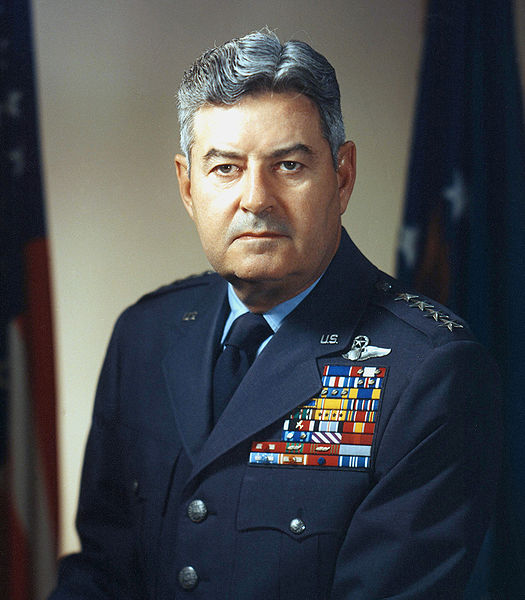Curtis LeMay
Curtis LeMay was an American pilot famous for promoting the ‘fire raid’ strategy during the Pacific War. Firebombing raids were effective in terms of American strategy, but had an enormous human cost: 200,000 to 500,000 Japanese civilians were killed.
Born in 1906, LeMay went to Ohio State University to study civil engineering and joined the Airs Corps Reserve in 1928 as a second lieutenant. LeMay was renowned for his efficiency and steely persona. His nickname was "Iron Ass".
At the time of America’s entrance into the war in December 1941, LeMay was head of the 8th Air Force. In 1942, he was put in command of the 305th Group, which was sent on European bombing missions. America’s air force conducted daylight raids and the RAF's Bomber Command conducted night time raids. LeMay himself flew in several hazardous missions over Germany.

In July 1944, Lemay transferred to the Pacific war zone. He was given command of the 21st Bomber Command.
LeMay felt America’s air force was following misguided tactics in Japan. High altitude precision bombing dominated America’s strategy, but it was riddled with difficulties: most bombs failed to reach their targets and operational plane losses were very high.
LeMay advocated a switch to low altitude incendiary raids at night to avoid Japanese aircraft defences. Over 60 Japanese cities were ‘fire-raided’; Tokyo was left devastated after a fire-bombing raid of March 1945. From 9 to 10 March, 100,000 civilians were killed and 250,000 buildings destroyed.
The civilian death toll of LeMay’s fire-raids is hard to calculate, but estimates usually state between 200,000 and 500,000. Up to 5 million Japanese citizens were made homeless. LeMay was convinced that his tactics were justified if they shortened the war and prevented future deaths. But he was aware that others might not see things differently: he later said that he expected to be charged with war crimes if America was defeated.
LeMay became Deputy Chief of Staff for Research and Development at the Pentagon once the war was over. As the relationship between the USSR and the West soured, LeMay was posted back to Europe to become the USAF’s commander in Europe.
Here he oversaw the Berlin Airlift; his anti-communist sentiments grew even more pronounced after this episode.
From 1949 to 1957 LeMay headed the Strategic Air Command. In 1961, LeMay became Chief of Staff of the USAF and retired just a few years later in 1965. He toyed with a retirement political career and in 1968 Governor George Wallace selected LeMay as his vice-presidential running mate. However Wallace's defeat put a premature end to LeMay’s political aspirations.
Curtis LeMay died on 1 October 1990.
See also: Douglas MacArthur
MLA Citation/Reference
"Curtis LeMay". HistoryLearning.com. 2026. Web.
